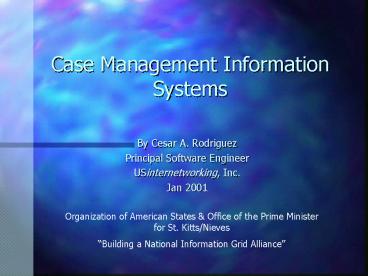Case Management Information Systems - PowerPoint PPT Presentation
1 / 21
Title:
Case Management Information Systems
Description:
'Using computers to model optimum process structures' ... Analytics via OLAP (Online Analytical Processing) Multidimensional analysis of data sets ... – PowerPoint PPT presentation
Number of Views:29
Avg rating:3.0/5.0
Title: Case Management Information Systems
1
Case Management Information Systems
- By Cesar A. Rodriguez
- Principal Software Engineer
- USinternetworking, Inc.
- Jan 2001
Organization of American States Office of the
Prime Minister for St. Kitts/Nieves Building a
National Information Grid Alliance
2
Agenda
- Overview
- CM Process Model
- Process Innovations
- Architectures
- Integration
- Reporting Quantitative Analysis
- Case Study
- Questions Answers
3
Overview
- What are they?
- Information Systems directly supporting
organizations engaged in case management
processes - CMIS have relatively Broad Industry Scope
- Health
- Social Services
- Judicial
- Others
- Psychosocial
4
Overview
- Brief History
- Been around since 60s 70s
- Mainframe based
- No real CM process support, more so a collection
of data - 80s Early days of the DOS based systems
- Some good beginnings in CM process support
- No critical mass adoption, DOS based systems
where not inherently easy to use - Late 80s to present, Windows based systems
- Advances in connectivity (LAN, MAN, WAN, GAN)
- Mid 90s to present, Web enabled systems
- Critical mass Internet adoption
- Today, Completely integrated systems
- All of the later
- Wireless systems
- Mobile size footprints
5
CM Process Model
- Relatively Standardized across industries
- Differences lie in
- Data
- Mix Process Components
6
Typical CM Process Structure
Screening
Intake
Assessment
Service Planning
Delivery
Outcome
Iterative Cycle
- Tracking
- Referrals
- Contacts
- Placements
- Others
- Program Management
- Orchestration
- Quantification
- Funding
7
Process Innovations
- Quantitative Assessments Automation
- Mathematical based approaches geared towards
objectively assessing client characteristics - Key is in the formulation of Assessment
Questions, structure, and algorithms - Computer provides the computational platform
8
Process Innovations
- Client-centric service delivery model
- Client is the focus, and process structures are
designed towards that goal - Adopted from business best-practices approaches
9
Process Innovations
- Process Modeling
- Using computers to model optimum process
structures - Play What if scenarios at low cost and risk
- Pilot new process introductions
- Work best when
- Guided by Steering committee
10
Client-Centric Service Delivery Model
- Benefits
- Unified set of services from client perspective
- Process efficiencies and productivity derived
from coordinated services
- Requirements
- Strategic Vision Buy-in from participants
- Process Modeling Effort
- Integration of Information Systems
11
Infrastructure Dependency Model
- Enterprise Process Structure
- Should Support Strategic Objectives
- Make use of Process Innovations
Enterprise Process Structure
- Enterprise Application
- Should Support Enterprise Process Structure
Enterprise Application
- Technology Infrastructure
- Should Support Enterprise Application
Enterprise Process Structure
Technology Infrastructure
12
Architecture Deployment Strategies
- Legacy
- Client/Server
- Web Enabled
- Wireless
- Hosted (Application Service Providers)
- Integrated
13
Legacy
- Centralized Model
- Everything is centralized
- Good for management, not responsive to users
Mainframe
Database
Terminal
14
Client/Server
- Distributed Model
- Systems are decentralized
- Responsive to users
- Difficult to manage
- Advances in Automated Management closing the gap
Clients
(Users)
Server
Network Public or Private
Database
15
Web Enabled
- Distributed WEB Model
- Systems are decentralized
- Extremely Responsive to users
- Ubiquitous access to IS from browsers
WEB Browser
(Users)
Server
Network Public or Private
Database
WEB Server
Clients
16
Wireless
- Distributed Wireless Model
- Systems are decentralized
- Extremely Responsive to users
- Ubiquitous access to IS from browsers
- Mobile - Information anytime anywhere
WEB Browser
(Users)
Server
Network Public or Private
Database
WEB Server
17
Hosted Systems
- Completely integrated systems hosted by an
application service provider - Offered as a service
- No capital investment
- Latest technologies and experts
- Programs concentrate on the business of CM, ASP
takes care of all MIS and technology
18
Integrated
- Integrated Model
- Systems are decentralized
- Ubiquitous access to IS from browsers
- Information Alliances and Collaboration across
global platform
Legacy
WEB Enabled
Integration Systems
Client/Server
Wireless
19
Reporting Quantitative Analysis
- Decouple reporting from CM system
- Utilize best-of-breed Reporting software
- With canned reports designed to specifically
support the CM process - Analytics via OLAP (Online Analytical Processing)
- Multidimensional analysis of data sets
- Superior for Visualization of information
- Statistical Trending
20
Integration
- Elegant technology for integrating information
silos - Leverage existing information systems
functionality - Integration transactions are abstracted from the
participating IS
21
Questions Answers































